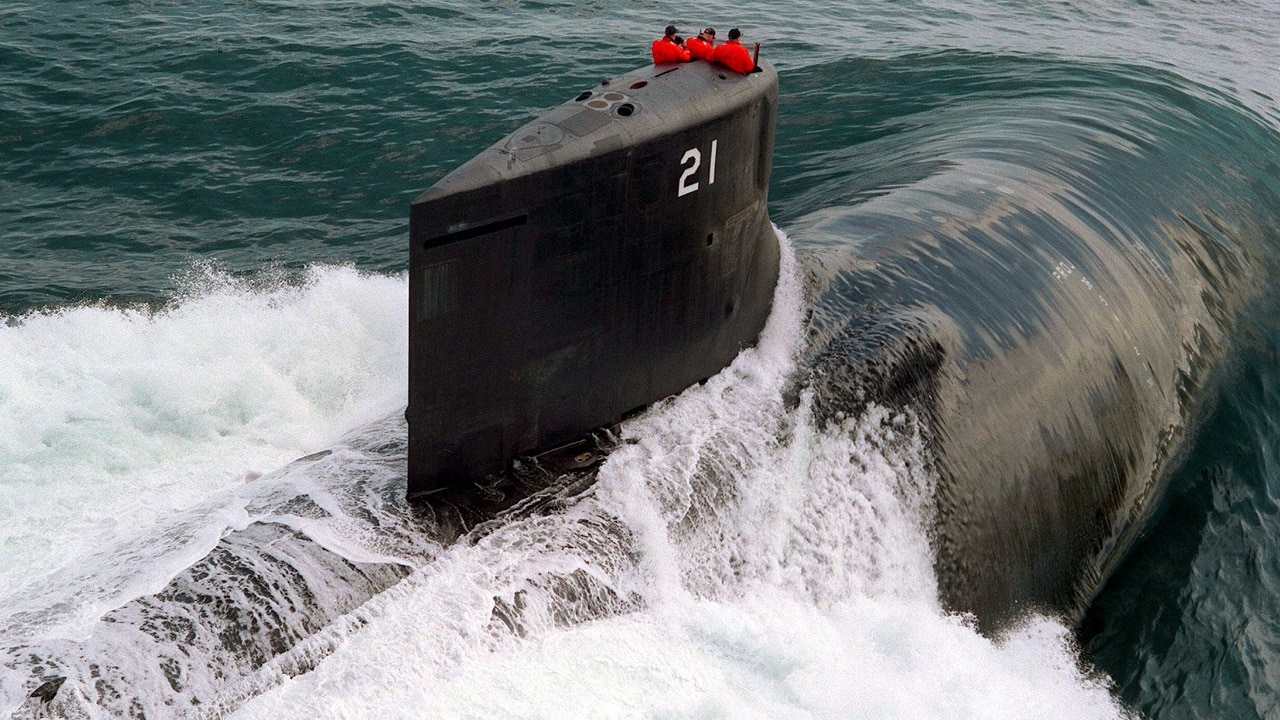Did you know the U.S. Navy is exploring the use of underwater drones, or UUVs, launched from submarines?
That’s what is happening with the torpedo-sized Razorback unmanned underwater vehicle. American subs can reportedly launch the UUV, but they are having trouble recovering the craft after it swims its mission. Despite the difficulties in recovery this is a significant feature for the Navy and will bring the submarine fleet into the business of deploying drones in the coming years.
What Is the Razorback?
Submarine Force commander Vice Admiral Bill Houston said on November 1 at the Naval Submarine League’s annual conference that the Navy can easily launch underwater drones but getting them back on the sub is a challenge. The medium-sized Razorback weighs 600 pounds, and it takes a team of divers to get it back in the boat. However, the system is close to being fully deployed by the Navy “in the very near future,” said Rear Admiral Doug Perry, the head of undersea warfare for the Office of the Chief of Naval Operations.
Underwater Robot Nearing Full Deployment
Perry believes the Navy will solve the drone recovery problem soon and that this shortcoming will not put the entire program at risk. The unmanned craft will have to find the torpedo tube to get back in the submarine when it is fully operational.
Mine and Explosive Ordnance Disposal
The Razorback UUV is based on an underwater robot called the Remus 600 from defense contactor HII. The project of converting the Remus 600 into the Razorback for Naval use is being executed by Leidos and L3 Harris in a contract worth $358 million. One mission will be for seeking out and disabling underwater mines. Another task will be explosive ordnance disposal. This Razorback will eventually go on missions of longer duration to cover larger expanses of ocean.
Protect Against Collisions in Uncharted Waters
The idea is to create the ability for all submarines to be a “drone mothership.” The drones can swim out ahead and extend the range for friendly submarines to detect enemy shipping and incoming torpedoes. They will create additional “eyes and ears” for the boats. They can also survey the ocean where the Navy has limited charts to find underwater seamounts that could damage submarines. The USS Connecticut fast attack sub ran into an uncharted seamount in October 2021. This crash injured 21 sailors. A Razorback deployed by the Connecticut may have avoided the catastrophe.
Defense and Offense?
Nine Razorbacks are currently in testing. It is not clear if the underwater drones will have offensive capability to assist with targeting enemy ships, but this would be a logical next step in their mission parameters.
Russia Has a Deadly Nuclear Underwater Unmanned Weapon
Russia is developing its Poseidon nuclear-tipped autonomous underwater drone that can be launched from thousands of miles away and attack coastal cities. The nuclear-powered torpedo would spread radioactive contamination over population centers to institute mass panic. The Razorback may be able to sense the Poseidon before submarines could detect it and allow for friendly torpedoes to destroy the Poseidon before it entered coastal areas.
More From 19FortyFive
Department of Defense: Russia’s PAK DA Stealth Bomber Will Never Fly
Iran to Send More Drones and Missiles to Russia
Is Russia Considering Using Tactical Nuclear Weapons?
China Has a Robotic Submarine
China also has an extra-large unmanned underwater vehicle that it has shown off in military parades. This is more of a robotic submarine due to its size as it would be larger than the Razorback. The Chinese unmanned craft would help improve situational awareness for friendly subs by also serving as eyes and ears.
What the Experts Told 19FortyFive
“It strikes me as one of those kinks you have to work out when marrying up a new platform with an old one. The image that leapt to mind was of the seaplanes that operated from battleships during World War II,” explained Dr. James Holmes of the U.S. Naval War College in an interview with 19FortyFive.
There were a couple of catapults on the fantail, so launching seemed to be no big deal, but the planes couldn’t land on the ship. So a plane would land in the water alongside and the ship had an installed crane to hoist it aboard. It worked, but a rather clunky arrangement. The submarine force is trying to make retrieving autonomous underwater vehicles less clunky, but you still have to think recovery will impinge on submarine operations. A torpedo tube is not a large space for a vehicle to find its way to, especially if the sub is maneuvering.
This chess game of developing unmanned underwater vehicles has the three adversaries rushing to improve capabilities for their drone warfare efforts. The United States may be somewhat late to the game, but it expects to catch up and deploy the Razorback soon and successfully transform its subs into drone motherships.
Expert Biography: Serving as 1945’s Defense and National Security Editor, Dr. Brent M. Eastwood is the author of Humans, Machines, and Data: Future Trends in Warfare. He is an Emerging Threats expert and former U.S. Army Infantry officer. You can follow him on Twitter @BMEastwood. He holds a Ph.D. in Political Science and Foreign Policy/ International Relations.
Want More 19FortyFive articles, news, and analysis on the top military, defense, national security, as well as politics and economics news? Follow us on Google News, Flipboard, YouTube, Facebook, Twitter, and Linkedin. Also, please don’t forget to sign up for our newsletter here. You can also find our code of publishing ethics and standards here.

